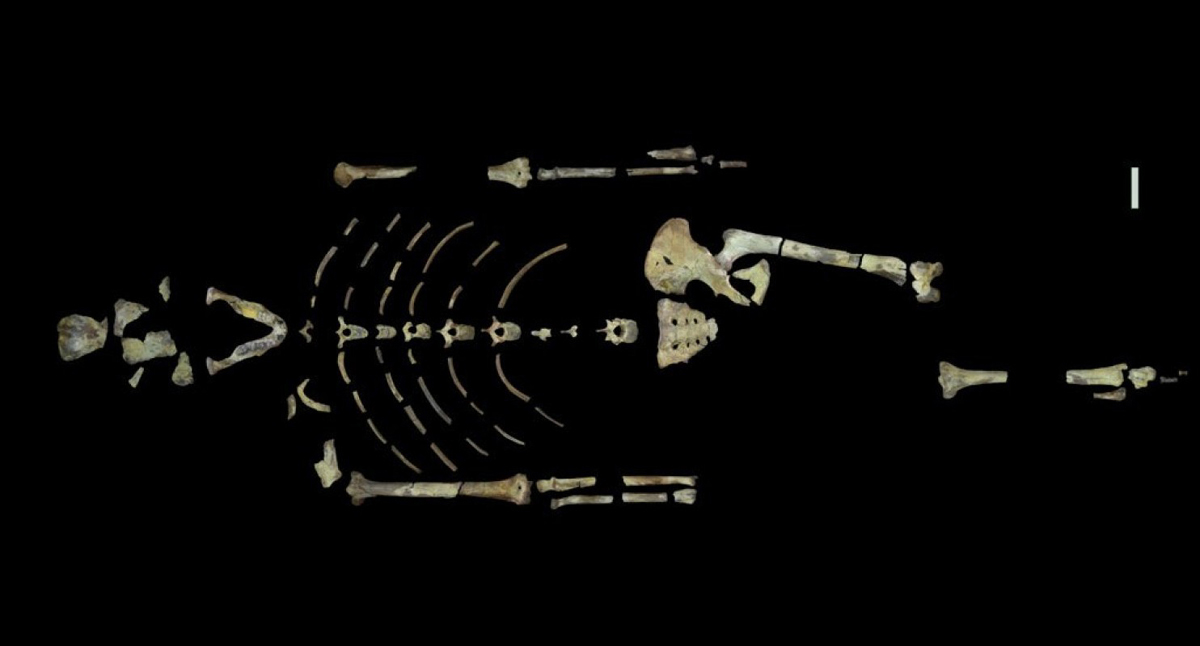


New research on the Australopithecus known as Lucy
|
An article by Sarah Kaplan on washingtonpost.com - New evidence that Lucy, our most famous ancestor, had superstrong arms - reports on the latest research on the assemblage of fossilized bones of the Australopithecus known as Lucy.

The fossils that make up Lucy's skeleton. Image: John Kappelman/University of Texas at Austin.
'Lucy' represents one of the most complete ancient hominid skeletons ever found; an assemblage of fossilized bones that has given scientists unprecedented insight into the history of humanity.
Lucy was discovered in 1974 in Ethiopia's Awash Valley. In some ways, the 3.2-million-year-old Australopithecus was a lot like us; her hips, feet and long legs were clearly made for walking. But she also had long arms and dexterous curved fingers, much like modern apes that still swing from the trees.
New research on the #Australopithecus known as Lucy https://t.co/OLHyqdmZdH #hominid #archaeology #Ethiopia pic.twitter.com/nii05tUmpz
— Bradshaw Foundation (@BradshawFND) December 1, 2016
A model of Lucy, one of the most famous human ancestors. Image: Michael Stravato/Associated Press.
So, who was Lucy? Was she lumbering and land-bound - bipedal - like us modern humans? Or did she retain some of the ancient climbing abilities - strong arm bones? A new study in the journal PLoS One suggests she was a little of both.
Lead author Christopher Ruff, a biological anthropologist at Johns Hopkins School of Medicine suggests that Lucy had crossed a lot of thresholds on the path to becoming human, but not all of them.
Reconstructing the lifestyle of a hominid who's been dead for 3.2 million years; fossils are bone turned to rock, making them impenetrable to the kinds of CT scans that were available for the first several decades after Lucy was discovered. But scientists can draw conclusions about Lucy's habits based on the shape of her skeleton; for example, her legs bent at the knee (an adaptation for bipedal walking) and her arms are much longer than those of a modern human (which would make her well suited for life in the trees).
But Ruff noted that those more chimp-like traits could be evidence of primitive retention - ancestral traits that stay in the skeleton even though they're no longer used.
He states that if she evolved from a more arboreal ancestor she may just not have had the time yet to evolve a shorter upper limb. We have to look at traits that changed during her life depending on how she used that part of her skeleton. That would be real evidence of what someone was actually doing.
Because bones develop 'strength characteristics' in response to heavy use, scientists can get answers by looking at a scan of a skeleton. And scientists at the University of Texas had advanced micro CT scanners capable of finding these characteristics in fossilized bone. During a 2008 tour of the U.S., Lucy was scanned at the UT lab in Austin.
The UT researchers produced cross sections of Lucy's right and left humeri (upper arm bones) and her left femur (thigh bone). They then compared the relative strength of those bones to samples from a range of other primate species. Lucy's arms were not as strong as those of chimps, but they were substantially stronger than those of modern humans.
Ruff argues that daily tree climbing is the most likely explanation for the strength of Lucy's arms. Perhaps Lucy and her relatives ventured into trees at night to prevent attacks from predators as they slept. Hominins had slowly developed adaptations for walking on the ground, but for millions of years we were still using the trees in a significant way. It was only with evolution of Homo the genus - about half a million years after Lucy - that we became fully committed to the ground.
Visit ORIGINS - Exploring the Fossil Record:
COMMENTS |
|











